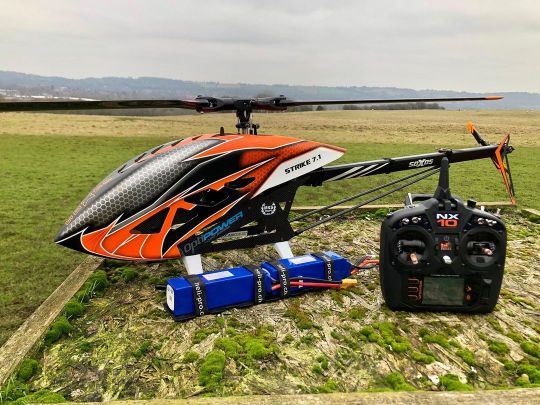#rchelis
Explore tagged Tumblr posts
Text
Full video https://www.youtube.com/watch?v=JhI-E0hFaCE
0 notes
Photo

7. Modellsporttreffen Seewen 2019 . . Photo: @fabian.huesser . . rcscale #rccar #scale #swiss_rc_instagramer #funktionsmodellbaupin #funktionsmodellbau #swissrc #swissrcchannel #scalerc #rcporn #rcscaletruck #modellbauer #rcmodellbau #rcgarage #rcheli #rchelis #rcschiffe #tweet #twitter #rcairplane #rcaircraft #rchelicopter (hier: Seebad Seewen) https://www.instagram.com/p/B3FXJ-Hi_wI/?igshid=ne5eliqsvs1b
#rccar#scale#swiss_rc_instagramer#funktionsmodellbaupin#funktionsmodellbau#swissrc#swissrcchannel#scalerc#rcporn#rcscaletruck#modellbauer#rcmodellbau#rcgarage#rcheli#rchelis#rcschiffe#tweet#twitter#rcairplane#rcaircraft#rchelicopter
1 note
·
View note
Photo

A faultless performance from the Strike 7.1 today in the rolling green hills of England 👍 new Spektrum NX10 radio works perfectly. Powered by a pair of Optipower 5300ma packs. Happy Sunday 😎 @heliprofessional @1st_rc #helicopter #helicopters #rchelicopter3d #rcheli #rchelis #modelhelicopter #radiocontrol #s #vbar #helilife #3dhelicopter #futaba @futabarc #futaba16iz @helyshopuk @soxoshelicopters.co.uk @spektrum_rc @tomthebomb_cogs @horizon_hobby https://www.instagram.com/p/CZFo8Q8tUrR/?utm_medium=tumblr
#helicopter#helicopters#rchelicopter3d#rcheli#rchelis#modelhelicopter#radiocontrol#s#vbar#helilife#3dhelicopter#futaba#futaba16iz
0 notes
Photo

Get it installed for your heli packs. #rchelis #leopardpower #leopardpowerbattery @leopardpowerbattery http://www.leopard-power.com https://www.instagram.com/p/Bwj9CuHnz1Q/?utm_source=ig_tumblr_share&igshid=1e3b8giboaaca
0 notes
Photo

Le tout premier avion RC que j'ai crasher et mon trex 100 qui est un bijou . #align #nanoracer #plane #rc #rcheli #rcplane #avion #telecommande #mecanique #technologie #theia #théiarob https://www.instagram.com/p/Cfl_DjNNqWH/?igshid=NGJjMDIxMWI=
0 notes
Photo





4 CHANNEL RC HELICOPTER WITH ALTITUDE HOLD
Stable and Easy to Fly RC Helicopter
This mid-size 4 Channel Rc Helicopter is stable and Easy to Fly. The single propeller blade design makes this helicopter quite agile and with the help of the altitude hold feature, helicopter control is a breeze. With one button take off and landing and 6 axis gyroscope, this helicopter is ideal for beginner flyers.
Supplied with a 2.4GHz Digital Remote Controller, you are able to control the RC Plane up to 120m in distance. The large capacity rechargeable battery will provide between 15 - 20 minutes of play time. A USB Battery Charger is supplied.
https://www.auselectronicsdirect.com.au/4-channel-rc-helicopter-with-altitude-hold
0 notes
Photo

🛩️Air🚗Land🚤Sea ⬇️🚗Enjoy The RIDE💨⬇️ 👉Follow us @livinfreerc for more #RCAction . . . #LivinFreeRC #rchobbies #hobbyrc #rcjet #rchobby #scalerc #rcjets #rchelocopter #rcheli #rcaircraft #serioustoys #scalemodel #customrcbuilds #rcscale #scalerc #scaleaircraft #scaleairplane #rcaviation #scaleaviation #customrc #radiocontrol #radiocontrolled #drone #rcaddiction #rclife #rclifestyle #rccommunity #Portland #ptown #portlandoregon (at Portland, Oregon) https://www.instagram.com/p/B-Pd9TpDIxz/?igshid=13dylooschpre
#rcaction#livinfreerc#rchobbies#hobbyrc#rcjet#rchobby#scalerc#rcjets#rchelocopter#rcheli#rcaircraft#serioustoys#scalemodel#customrcbuilds#rcscale#scaleaircraft#scaleairplane#rcaviation#scaleaviation#customrc#radiocontrol#radiocontrolled#drone#rcaddiction#rclife#rclifestyle#rccommunity#portland#ptown#portlandoregon
0 notes
Text
No so easy to learn....
0 notes
Text
youtube
Tricky Take-offs Part 2 is live!
0 notes
Photo

7. Modellsporttreffen Seewen 2019 . . Photo: @fabian.huesser . . rcscale #rccar #scale #swiss_rc_instagramer #funktionsmodellbaupin #funktionsmodellbau #swissrc #swissrcchannel #scalerc #rcporn #rcscaletruck #modellbauer #rcmodellbau #rcgarage #rcheli #rchelis #rcschiffe #tweet #twitter #rcairplane #rcaircraft #rchelicopter (hier: Seebad Seewen) https://www.instagram.com/p/B3Kd7tLCY6L/?igshid=1gldvfer7kq1x
#rccar#scale#swiss_rc_instagramer#funktionsmodellbaupin#funktionsmodellbau#swissrc#swissrcchannel#scalerc#rcporn#rcscaletruck#modellbauer#rcmodellbau#rcgarage#rcheli#rchelis#rcschiffe#tweet#twitter#rcairplane#rcaircraft#rchelicopter
0 notes
Photo

Super slick SAB Goblin Fireball should be available now over at AMAIN!! We have more specs and a video up on the website! Click on RCHUB.com for more details! #amainhobbies #sab #goblin #fireball #helicopter #competition #brushless #kit #lipo #carbonfiber #heli #stunts #flying #upupandaway #airborne #rc #rcheli #rcflight #rchelicopter #rchobbies #flying #rcflying #rchub @rchub @amainhobbies
#upupandaway#amainhobbies#rchobbies#rchub#brushless#rcflying#heli#kit#rc#lipo#competition#flying#stunts#sab#rcheli#fireball#rchelicopter#helicopter#airborne#goblin#rcflight#carbonfiber
1 note
·
View note
Photo

I frequently browse Craigslist looking for deals. Earlier this summer I think I may have found the deal of the year where I purchased a large RC collection that filled the box of my pickup truck. Which included: Yuneec Typhoon Q500 DJI Alien F450 Eachine goggles FLYSKY FS-TH9X Transmitter and much much more. • #rchelicopter #rcheli #walkera #craigslist #craigslistfinds #rc #drone #quadcopter #youtubechannel #vancityrc #contentcreator #youtuber https://www.instagram.com/p/B2dVuwKHeEQ/?igshid=1ibof5dlkp83f
#rchelicopter#rcheli#walkera#craigslist#craigslistfinds#rc#drone#quadcopter#youtubechannel#vancityrc#contentcreator#youtuber
0 notes
Text












SRCM JetModel Meetup 2023 - Part 4
2 notes
·
View notes
Text











SRCM JetModel Meetup 2023 - Part 3
2 notes
·
View notes
Text











SRCM JetModel Meetup 2023 - Part 2
2 notes
·
View notes